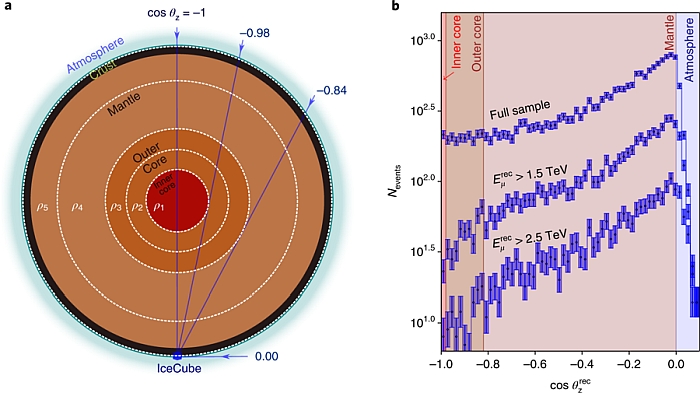Earth is too big to fit into an X-ray or MRI scanner, so a group of physicists in Spain found a fascinating new way to peer inside - they used the subatomic particles constantly streaming through the planet.
The team scanned the interior of Earth using neutrinos - and even used them to conduct an entirely new measurement of our planet's mass.
Neutrinos are odd little things. They are among the most abundant particles in the Universe, and yet are hard to detect. They're similar to electrons, but they have no electrical charge and their mass is almost zero, so they interact very little with normal matter as they stream through the Universe at near light-speed.
Billions of neutrinos are zipping through your body right now. You can see why they are called "ghost particles."
While historically our detection efforts have been poor, the IceCube neutrino detector all the way down in Antarctica has opened up a brave new world of neutrino science.
Using a year's worth of IceCube data, physicists at the Institute for Corpuscular Physics (IFIC) in Valencia, Spain, were even able to study Earth's guts.
It worked almost exactly like an X-ray. When you are being X-rayed, beams are sent through your body. They mostly pass through soft tissue like muscle and organs. However, denser material, like bone, absorbs the beams at a higher rate, so fewer X-rays hit the detector on the other side, producing an image of your skeleton.
Instead of X-rays, though, the team used atmospheric neutrinos, showers of which are created when energetic particles from space collide with Earth's atmosphere. These then zoom through Earth - but can be absorbed by the atomic nuclei of the material they pass through.
The denser the material, the higher the absorption rate; which, in turn, allowed the research team to put together a study of the planet's density.
"The use of atmospheric neutrinos allows us to have neutrinos coming from all directions, with a wide range of energy and a known flux with enough precision," explained IFIC physicist Sergio Palomares-Ruiz.
"The amount of absorption of atmospheric neutrino flux depends on the amount of material traversed as well as the energy of the neutrinos, so by studying the variation of the amount of absorption in different directions for neutrinos of different energy, we can determine the distribution of density of the Earth."
 (Donini et al./Nature Physics)
(Donini et al./Nature Physics)
The different angles are a big factor here. Some neutrinos travelled all the way through Earth's core, while others travelled at an oblique angle that skipped the core entirely.
Analysing both the concentration and the angle gave the team the tools to calculate the density of the planet at various depths.
Traditionally, Earth's density is extrapolated from the way seismic waves produced by earthquakes propagate. However, seismic waves can't penetrate the inner core.
"The neutrinos, on the other hand, go through it all, offering valuable information about the unknown nucleus of the Earth, where the magnetism of the planet is generated," said IFIC physicist Andrea Donini.
The team didn't learn anything new about our planet. The density map of Earth's interior, the planet's mass and its moment of inertia were all calculated using neutrino data - and they were all consistent with previous measurements taken by other means, and less detailed.
But the point of the research wasn't to learn anything new about Earth - it was to learn something new about what we can learn from neutrinos. And on that score the results are really freaking awesome.
"Our results demonstrate the feasibility of this approach to study the Earth's internal structure, which is complementary to traditional geophysics methods," the researchers wrote in their paper.
At the moment, though, neutrino data is still relatively scarce; the researchers hope their research will encourage the release of more recent IceCube data, as well as more neutrino science in the years to come.
The paper has been published in Nature Physics.
